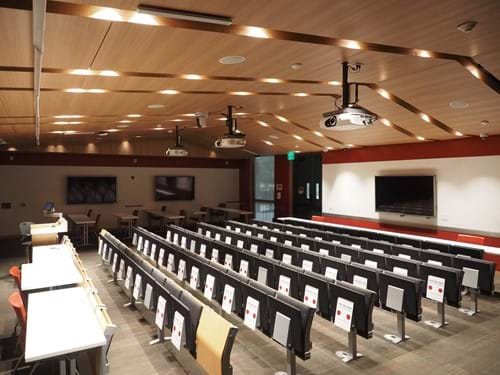Why Higher Education Institutions are Choosing Digital Signal Processing Software to Enhance Learning

Flexible digital signal processing (DSP) in these different environments is essential, as it helps to remove unwanted noise and echo and improves the audio quality and intelligibility of the talker’s voice that is being sent to a live stream or recording.
They have rolled out popular collaboration software, such as Zoom and Microsoft Teams, for remote learning and using lecture capture systems to provide recordings of each lesson. These systems are being integrated with networked audio technology to capture every word and nuance accurately.
But what happens when students are on campus — whether in a full, or part-time capacity? New learning models demand flexible learning spaces that can accommodate small student cohorts yet cost effectively scale up as more students return to physical lessons. At the same time, there is a need to provide a high-quality learning experience to remote learners, or students watching a recorded lesson.
Leading the flexible learning revolution with DSP
Without doubt, we’re seeing a revolution in education. Flexible learning solutions will become the norm and remote learning is here to stay. Whether it’s a teacher lecturing remote students, students in a classroom listening to an instructor from a satellite location, or lecture capture for later viewing, the audio quality of these applications is crucial to ensure learning excellence for each student. Flexible digital signal processing (DSP) in these different environments is essential, as it helps to remove unwanted noise and echo and improves the audio quality and intelligibility of the talker’s voice that is being sent to a live stream or recording.
Discussion is an essential element of most course content and a remote lecture with poor audio quality is not good enough. The questions and student discussions in class can also support comprehension of complex topics. Audio clarity is thus vital. Each participant should be able to speak with and hear everyone else — requiring full room coverage and clear audio processing. This is especially relevant in the now-familiar hybrid learning scenario of students both in the room with a professor and watching remotely on the far end of a video conference call. One solution is automatic mixing, which can help to pinpoint who is talking in the room and deliver their voice at a consistent volume level to students listening at home.
IntelliMix® Room Audio Processing Software is well ahead of the curve in this respect. IntelliMix Room is optimized for Shure microphones, such as the Microflex® Advance™ range of Array Microphones, for pristine sound quality. Crucially, directional mic pickup in conjunction with our optimized DSP allows everyone to be heard.
Making the case for software DSP
Our work with Higher Education institutions has revealed the key reasons for choosing high-quality software-based DSP:
- Easy to deploy: It is software-based, so it’s easy to deploy, download and install on the existing in-room computer that is hosting the software-based conference application. There’s no need to unbox and install multiple DSP units, which saves valuable time during an installation.
- Flexibility: A software-based DSP offers scope to go ‘all in’ with digital audio, giving you the freedom to create a highly flexible system that’s not reliant on fixed hardware assets. The software can also be transferred to new computers as old ones become outdated.
- Scalability: It might be a few rooms today, but as demand grows, so does the reach of software-based DSP with deployment directly to in-room PCs. And if a small room needs to be opened up into a bigger space, the sound quality remains consistently high quality. IT and AV leaders can add capabilities as and when they are required, sending audio to different rooms, no matter how many are needed.
- Mute Sync: Ensures that all connected devices in a conferencing system mute or unmute at the same time and at the correct point in the signal path, including sync with software-based conference applications like Zoom and MS Teams. Mute status is synchronized in the devices using logic signals or USB connections.
- Ease of use: No wires. No boxes. It just runs in the background and enhances the audio quality. The software is invisible to lecturers and students alike. It enables clear audio during live streaming of lectures and recordings for students to revisit.
- Budget-friendly: By removing the need for hardware, this approach democratizes high-quality audio for Higher Education. It is license-based, so once you’ve bought your licenses any functionality updates are included.
Future-proofing learning
The University of Southern California has also transformed its AV landscape with a Shure solution. USC discovered they could equip twice the number of rooms (224) than they expected for the same price by switching to IntelliMix Room software. Joe Way at USC explains:
“In the past, the technologies in use at USC were seen as something that inhibited people’s ability to teach or learn, so we wanted to remove those barriers, empowering the faculty to focus on teaching and the students to focus on learning. I think we’ve achieved that frictionless experience.”
IntelliMix Room offers Higher Education IT and AV decision-makers a simple way to optimize the unified video conferencing platforms that are aiding new learning models. And while it’s a professional AV solution, IntelliMix Room also bridges into consumer codecs, like Zoom and MS Teams. For example, we’ve given it a consumer-like feel, including LED functionality on our mics that let lecturers know if they have muted the microphone.
Find out more
Interested in hearing more about IntelliMix Room for Higher Education? Contact one of our experts here.
When using connections such as analog or mobile, or using a hardware codec without a PC, consider the IntelliMix P300 Audio Conferencing Processor or ANIUSB-MATRIX USB Audio Network Interface.

Related Posts
It’s time to redefine the workplace
As the future of work continues to evolve, and the importance of communication and collaboration increases, reconfiguring collaboration spaces to build the right employee experience is now critical. IDC believes that investments to enhance hybrid meetings through audio quality can lead to tangible business outcomes.
IDC Video : Audio Issues with Hybrid Working Models
IDC Explores how quality audio can overcome the issues and consequences associated with hybrid working.